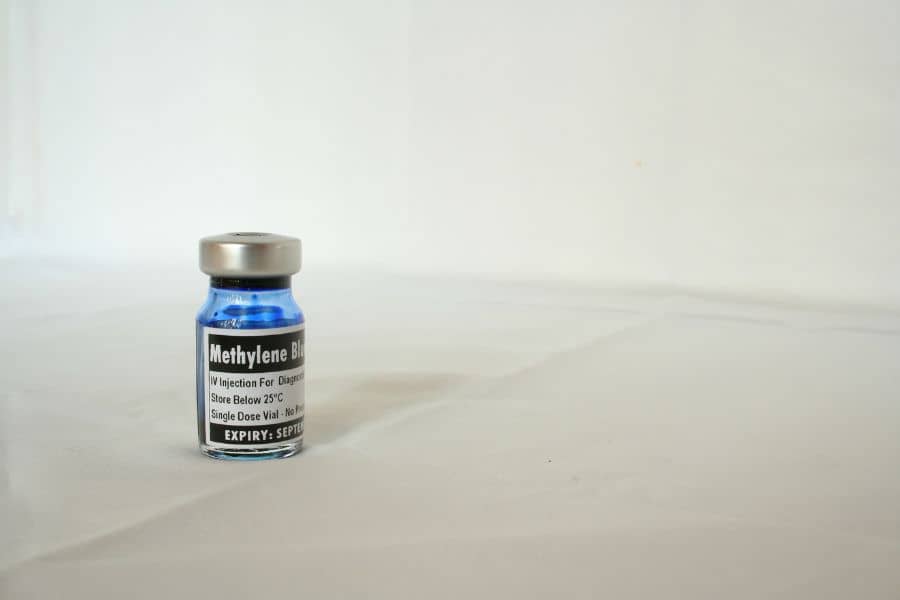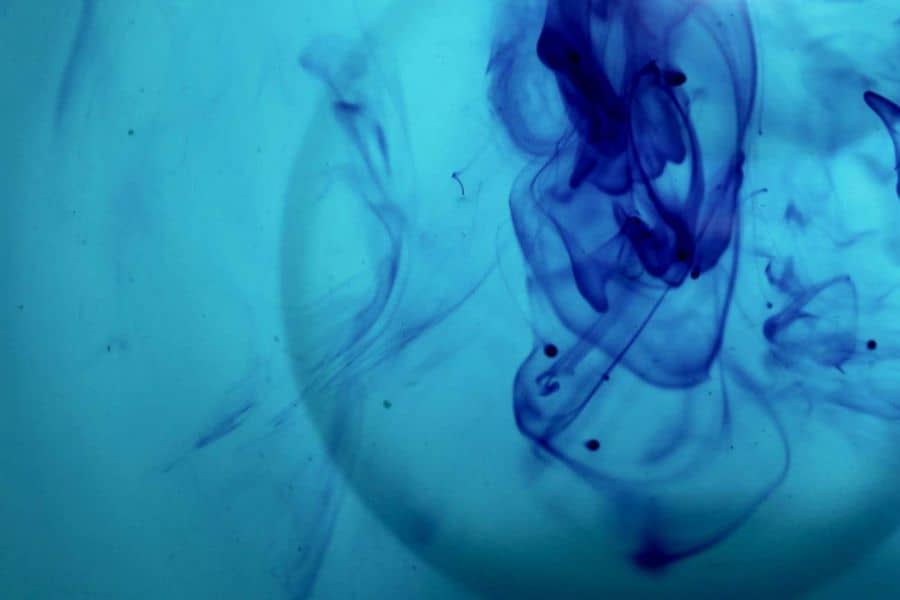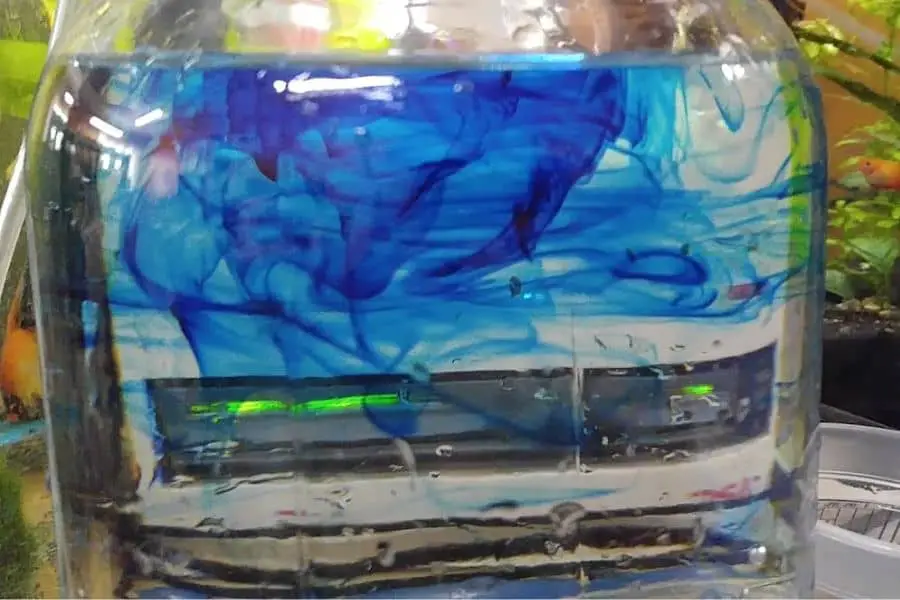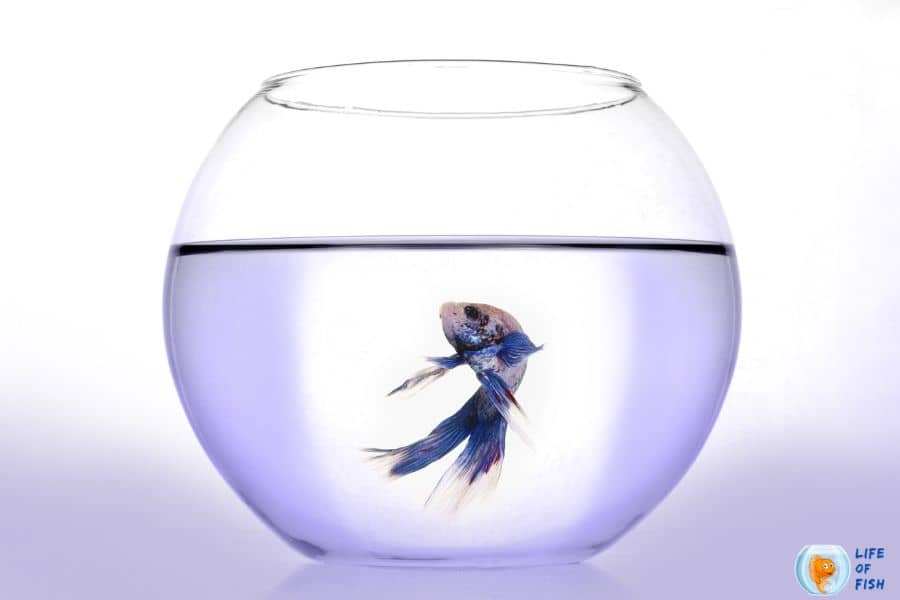Methylene Blue is a leading medication used to treat various ailments in fish, especially in the aquarium industry. It is a widely used dye in many different industries. It has a long history of use as a dye for fabric, but it is also used as a food coloring and in medical treatments. Although we use this chemical to treat fish, is it safe for fish? Can Methylene blue kill fish? Let’s discuss the potential dangers of using Methylene blue in fish tanks and how to use it safely.

What is Methylene Blue?
Jump To
- 1 What is Methylene Blue?
- 2 Is Methylene Blue Safe For Fish?
- 3 How Does Methylene Blue Work For Fish?
- 4 How Quickly Does Methylene Blue Work?
- 5 How Long Can You Leave Fish In Methylene Blue?
- 6 Can Methylene Blue Kill Fish?
- 7 What Happens When You Put Too Much Methylene Blue?
- 8 What Should You Do If You Put Too Much Methylene Blue In A Fish Tank?
- 9 How Can You Prevent Methylene Blue Toxicity In Fish?
- 10 When To Use Methylene Blue For Fish
- 11 How To Use Methylene Blue For Fish
- 12 Precautions While Using Methylene Blue For Fish
- 13 Conclusion
- 14 Related questions
Methylene blue is a chemical compound that is widely used as a dye. This compound is also known by other names such as methylthioninium chloride and tetramethyl thionine chloride. It is a synthetic organic compound, and its molecular formula is C₁₃H₁₄N₃SCl. Methylene blue is a dark blue powder that is insoluble in water. It is used as a dye because it absorbs light in the blue-green region of the visible spectrum. This compound is also used as a food coloring and in medical treatments.
Methylene blue was first synthesized in 1876 by German chemist Heinrich Caro. The first use of this compound was as a textile dye. Later, scientists discovered this chemical’s medicinal benefits and started using it in medical treatments. Nowadays, methylene blue is used to treat various conditions in fish.
Is Methylene Blue Safe For Fish?
Methylene blue is generally considered safe for fish. This chemical is often used to treat sick fish and prevent disease spread in fish tanks. You can also use methylene blue to increase the oxygen levels in fish tanks. However, methylene blue can be toxic to fish if it is used in high concentrations. If you use too much methylene blue, it can kill your fish. That is why it is critical to follow the instructions on the product package and only use the appropriate amount.
How Does Methylene Blue Work For Fish?
Methylene Blue works by raising the oxygen levels in the fish’s blood. This chemical is absorbed into the bloodstream of fish through their gills. Once methylene blue is in the bloodstream, it increases oxygen availability in the blood. This helps to treat conditions such as anemia and respiratory distress in fish. Methylene blue is also used to prevent the spread of disease in fish tanks. This chemical can kill bacteria and parasites that cause disease in fish.
How Quickly Does Methylene Blue Work?
Methylene blue works quickly to increase the oxygen levels in the blood of fish. Further, it works immediately to fight and kill the offending organisms by oxidizing them. However, the effects of this chemical only last for a few hours. That’s why it’s important only to use methylene blue when necessary and to follow the instructions on the product label.
How Long Can You Leave Fish In Methylene Blue?
You should only leave fish in methylene blue for a short period of time. The recommended time is no more than 10 seconds. The chemicals start to work under 10 seconds, so there is no need to leave the fish in longer than that. Leaving fish in methylene blue for too long can be harmful and even fatal.
Can Methylene Blue Kill Fish?
Like any other medication, excess methylene blue can be toxic and even fatal to fish. However, using too less is ineffective. That’s why it is critical to follow the instructions on the product label and only use the recommended amount. Methylene blue is a chemical compound that is safe and effective for fish when used as directed.
What Happens When You Put Too Much Methylene Blue?
If too much methylene blue is added to a fish tank, it can cause the water to turn a bright blue color. This is because methylene blue is a powerful oxidizing agent that can convert hemoglobin into methemoglobin. Methemoglobin cannot bind oxygen, so the fish in the tank will not be able to get the oxygen they need to survive. The fish will suffocate and perish as a result of this.
In addition, too much methylene blue can be toxic to the fish and cause them to experience neurological problems such as incoordination, convulsions, and paralysis.

What Should You Do If You Put Too Much Methylene Blue In A Fish Tank?
If you put too much methylene blue in a fish tank, you should immediately remove the fish and place them in another tank of clean water. You should also remove any activated carbon from the filter and do a partial water change to remove as much methylene blue from the water as possible. If you are uncertain how to safely remove the fish from the methylene blue, seek the advice of a veterinarian or fish expert.
How Can You Prevent Methylene Blue Toxicity In Fish?
The best way to prevent Methylene blue toxicity in fish is only to use the recommended amount. You should also remove the fish from the tank if they show any signs of distress, such as incoordination, convulsions, or paralysis. If you think your fish have been exposed to too much methylene blue, you should immediately remove the fish and place them in another clean water tank. If your fish is a sensitive one, we recommend doing partial water changes gradually to remove as much methylene blue from the water as possible.
When To Use Methylene Blue For Fish
Now that you know, using too much Methylene Blue can be toxic to fish and even cause death, so it is important to use it only when necessary. Let’s find out the possible applications of Methylene Blue for fish. Methylene blue can be used in the following cases:
Nitrate Poisoning
It is a life-threatening condition that can occur when nitrate levels in the water rise too high. Nitrate poisoning can cause fish to experience difficulty breathing, increased heart rate, and lethargy. If left untreated, nitrate poisoning can be fatal. Methylene blue can be used to treat nitrate poisoning in fish. The recommended dose is one drop of methylene blue per gallon of water.
Ammonia Poisoning
It is another life-threatening condition that can occur when ammonia levels in the water rise too high. Ammonia poisoning can cause fish to experience burning of the skin, difficulty breathing, increased heart rate, and lethargy. If left untreated, ammonia poisoning can be fatal. Methylene blue can be used to treat ammonia poisoning in fish. The recommended dose is one drop of methylene blue per gallon of water.
Fungus On Fish Eggs
The fungus can cause fish eggs to become infected and kill the developing embryos. Fish eggs of certain species (such as Corydoras) are particularly susceptible to fungal infections. Methylene blue can be used to treat fungus on fish eggs. You can also use Methylene Blue as a preventative measure by adding it to the water after your fish has laid eggs. The recommended dose is one drop of methylene blue per gallon of water.
Velvet Disease
One of the most common ailments in aquarium or tank fish is Oodinium, also known as Velvet disease, which is caused by the parasites Oodinium limnetic and Oodinium pilularis. These parasites affect both saltwater and freshwater fish. To flee the velvet, they scrape against hard surfaces, although when attacked, they become sluggish and heavy breathing occurs quickly and laboriously. Skin peels off in severe cases as a result of scraping against objects. Even a small amount of ‘Methylene Blue’ can serve as an antiparasitic in this scenario.
Stress
In fish, as in other animals, stress can lead to a number of problems, including impaired immune function, reduced fertility, and an increased risk of disease. In order to mitigate the effects of stress in fish, many aquarists use prophylactic therapies, such as methylene blue. Methylene blue is a substance that has been shown to have antidepressant effects in fish. It is often used to reduce stress when fish are transferred between tanks or when the conditions in their tanks change.
Ick
Ichthyophthirius multifiliis often called ick, is a common skin infection in fish. It is analogous to a skin infection in humans and can cause the fish to become sluggish and claw at the gravel or pebbles in their tank. In more severe cases, the fish’s skin develops tiny white spots resembling sand and crimson streaks or redness.
Methylene blue therapy may be useful in the treatment of Ichthyophthirius multifiliis parasites, but a combination of formaldehyde and malachite green is more effective.
Fungal Infections in Fish
Fungal infections are common in aquarium fish and can be fatal if left untreated. The most common symptom of a fungal infection is white patches on the skin or fins. Other symptoms include lethargy, loss of appetite, and difficulty breathing. You can use Methylene blue to treat fungal infections in fish. The recommended dose is one drop of methylene blue per gallon of water.
Swim Bladder Disease
The swim bladder is an essential organ for fish. It helps them control their buoyancy and maintain their position in the water. When it doesn’t function properly, it can cause the fish to sink to the bottom of the aquarium or struggle to stay afloat. This condition is known as swim bladder disease and can be caused by a variety of factors, such as infection, disease, or physical defect. Symptoms of swim bladder disease include sinking to the bottom of the tank, struggling to stay in place, standing on their head, floating upside down, and having difficulty staying buoyant. The physical appearance of an infected fish can also be affected, with a curved back or swollen belly being common. Methylene Blue is an effective treatment for swim bladder disease.

How To Use Methylene Blue For Fish
The application of Methylene blue varies depending on the condition being treated.
For External Parasitic Protozoans (Ick, Velvet, Flukes, etc.), Ammonia Poisoning, Nitrate Poisoning, and Cyanide Poisoning.
Since other fish are also susceptible to these diseases, you should treat the whole tank rather than just the affected fish. This will assist in the prevention of disease spread. First, you should remove the carbon filter and replace it with a mechanical filter during the treatment. Add one teaspoon of methylene blue per 10 gallons of water to treat these diseases. The recommended treatment time is 2-3 weeks. You should continue adding Methylene Blue every 3 to 5 days until the disease is gone.
For Fungal Infections, Swim Bladder Disease, and other internal illnesses (As a Dip)
If you don’t see any other fish who is affected by the infection, you can treat only the sick fish. To do this, you will need to set up a hospital tank. Any small container big enough to hold the fish will work. Fill the hospital tank with 1 gallon of water for each inch of fish. So, if you have a 3-inch fish, you’ll need 3 gallons of water. Add five teaspoons of methylene blue for every 3 gallons of water. Put the fish into the solution and take it back within 10 seconds. You shouldn’t keep the fish in the methylene blue for more than 10 seconds. After the treatment, return the fish to the main aquarium. You may have to continue the treatment for up to 2 weeks.
For Fungal Infections in Fish Eggs
First, you will have to remove the eggs from the main tank. If you bred the fish in a breeding tank, you could simply transfer the parents to the main tank. Assuming only the eggs are present, you can directly add Methylene Blue to the breeding tank at one drop per gallon concentration. You can use the treatment as a preventative measure for healthy eggs. Only one application is required. You should maintain treatment for a total of three days after the free-swimming stage or two days after birth in livebearers.
Precautions While Using Methylene Blue For Fish
- Methylene Blue is safe to use with crustaceans, including crabs, shrimp, and snails. However, it should be introduced carefully.
- Methylene Blue can damage live plants, so it should be used with caution in such cases
- Methylene Blue should not be combined with Erythromycin or Tetracycline.
- Wait 30 minutes after using a Redox-reducing type of water treatment (which includes most water conditioners) before adding Methylene Blue.
- You should not use carbon filters while treating since they will remove the Methylene Blue.
- You should remove any biological filters while treating since the Methylene Blue will kill the beneficial bacteria.
- Methylene Blue can temporarily discolor the water, but this is not harmful to the fish.
- Methylene blue is toxic to people if ingested, so take care not to spill it or get it on your skin or in your eyes. If you do, be sure to wash it off immediately and seek medical attention if necessary.
- Always use the recommended dosage of Methylene Blue, as using too much can be harmful to your fish.
Conclusion
Methylene blue is a safe and effective way to treat a variety of fish diseases. When used as directed, it can help your fish to recover from illnesses and prevent the spread of infections to other fish in your aquarium. However, overdosing on Methylene blue can kill your fish, so be sure to follow the recommended dosage for your fish’s particular condition.

Related questions
Does Methylene Blue Kill Parasites In Fish?
Methylene blue is effective against a variety of parasites, including Protozoans, Flagellates, Ciliates, and Nematodes. You can use it to treat both external and internal parasites. When used as directed, it is safe and effective for most fish. However, some fish are more sensitive to Methylene blue than others and may experience adverse effects at lower concentrations. If you are concerned about using Methylene blue with your fish, please consult a qualified veterinarian.
Does Methylene Blue Cure Fin Rot?
Methylene blue does not cure fin rot. However, You can use it to treat secondary fungal infections that may occur as a result of the fin rot. When used as directed, it is safe and effective for most fish.
Can Methylene Blue Kill Fish Lice?
Yes. Methylene blue is effective against a variety of external parasites, including fish lice.
Read Next : How Do Deep Sea Creatures Survive? (A Mystery Reveled)

